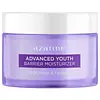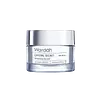What's inside
What's inside
 Key Ingredients
Key Ingredients

 Benefits
Benefits

 Concerns
Concerns

No concerns
 Ingredients Side-by-side
Ingredients Side-by-side

Water
Skin ConditioningGlycerin
HumectantSqualane
EmollientPropanediol
SolventPanthenol
Skin ConditioningCeramide NP
Skin ConditioningChlorphenesin
AntimicrobialPolyacrylate Crosspolymer-6
Emulsion StabilisingCaprylic/Capric Triglyceride
MaskingPhytol
EmollientIsomalt
HumectantButylene Glycol
HumectantSodium Hyaluronate
HumectantPentylene Glycol
Skin ConditioningPistacia Lentiscus Gum
MaskingLecithin
EmollientGlyceryl Caprylate
EmollientPotassium Hyaluronate
Skin ConditioningSodium Hyaluronate Crosspolymer
HumectantSodium Acetylated Hyaluronate
HumectantHydroxypropyltrimonium Hyaluronate
Hydrolyzed Hyaluronic Acid
HumectantHyaluronic Acid
HumectantHydrolyzed Sodium Hyaluronate
Skin ConditioningClitoria Ternatea Flower Extract
Skin ConditioningAcetyl Hexapeptide-8
HumectantWater, Glycerin, Squalane, Propanediol, Panthenol, Ceramide NP, Chlorphenesin, Polyacrylate Crosspolymer-6, Caprylic/Capric Triglyceride, Phytol, Isomalt, Butylene Glycol, Sodium Hyaluronate, Pentylene Glycol, Pistacia Lentiscus Gum, Lecithin, Glyceryl Caprylate, Potassium Hyaluronate, Sodium Hyaluronate Crosspolymer, Sodium Acetylated Hyaluronate, Hydroxypropyltrimonium Hyaluronate, Hydrolyzed Hyaluronic Acid, Hyaluronic Acid, Hydrolyzed Sodium Hyaluronate, Clitoria Ternatea Flower Extract, Acetyl Hexapeptide-8
Water
Skin ConditioningEthylhexyl Methoxycinnamate
UV AbsorberButylene Glycol
HumectantNiacinamide
SmoothingButyl Methoxydibenzoylmethane
UV AbsorberOctocrylene
UV AbsorberButyloctyl Salicylate
Skin ConditioningCyclopentasiloxane
EmollientPentylene Glycol
Skin ConditioningVinyldimethicone
Arachidyl Alcohol
EmollientAluminum Starch Octenylsuccinate
AbsorbentBisabolol
MaskingAlpha-Arbutin
AntioxidantActinidia Polygama Fruit Extract
Skin ConditioningLeontopodium Alpinum Extract
Skin ConditioningAmmonium Acryloyldimethyltaurate/Vp Copolymer
Behenyl Alcohol
EmollientArachidyl Glucoside
EmulsifyingParfum
MaskingSodium Hydroxide
BufferingGlycerin
HumectantCitric Acid
BufferingPotassium Sorbate
PreservativeSodium Benzoate
MaskingChlorphenesin
AntimicrobialPhenoxyethanol
PreservativeWater, Ethylhexyl Methoxycinnamate, Butylene Glycol, Niacinamide, Butyl Methoxydibenzoylmethane, Octocrylene, Butyloctyl Salicylate, Cyclopentasiloxane, Pentylene Glycol, Vinyldimethicone, Arachidyl Alcohol, Aluminum Starch Octenylsuccinate, Bisabolol, Alpha-Arbutin, Actinidia Polygama Fruit Extract, Leontopodium Alpinum Extract, Ammonium Acryloyldimethyltaurate/Vp Copolymer, Behenyl Alcohol, Arachidyl Glucoside, Parfum, Sodium Hydroxide, Glycerin, Citric Acid, Potassium Sorbate, Sodium Benzoate, Chlorphenesin, Phenoxyethanol
 Reviews
Reviews

Ingredients Explained
These ingredients are found in both products.
Ingredients higher up in an ingredient list are typically present in a larger amount.
Butylene Glycol (or BG) is used within cosmetic products for a few different reasons:
Overall, Butylene Glycol is a safe and well-rounded ingredient that works well with other ingredients.
Though this ingredient works well with most skin types, some people with sensitive skin may experience a reaction such as allergic rashes, closed comedones, or itchiness.
Learn more about Butylene GlycolChlorphenesin is a synthetic preservative. It helps protect a product against bacteria in order to extend shelf life. In most cases, Chlorphenesin is paired with other preservatives such as phenoxyethanol and caprylyl glycol.
Chlorphenesin is a biocide. This means it is able to help fight the microorganisms on our skin. It is also able to fight odor-releasing bacteria.
Chlorphenesin is soluble in both water and glycerin.
Studies show Chlorphenesin is easily absorbed by our skin. You should speak with a skincare professional if you have concerns about using Chlorphenesin.
Learn more about ChlorphenesinGlycerin is already naturally found in your skin. It helps moisturize and protect your skin.
A study from 2016 found glycerin to be more effective as a humectant than AHAs and hyaluronic acid.
As a humectant, it helps the skin stay hydrated by pulling moisture to your skin. The low molecular weight of glycerin allows it to pull moisture into the deeper layers of your skin.
Hydrated skin improves your skin barrier; Your skin barrier helps protect against irritants and bacteria.
Glycerin has also been found to have antimicrobial and antiviral properties. Due to these properties, glycerin is often used in wound and burn treatments.
In cosmetics, glycerin is usually derived from plants such as soybean or palm. However, it can also be sourced from animals, such as tallow or animal fat.
This ingredient is organic, colorless, odorless, and non-toxic.
Glycerin is the name for this ingredient in American English. British English uses Glycerol/Glycerine.
Learn more about GlycerinPentylene glycol is typically used within a product to thicken it. It also adds a smooth, soft, and moisturizing feel to the product. It is naturally found in plants such as sugar beets.
The hydrophilic trait of Pentylene Glycol makes it a humectant. As a humectant, Pentylene Glycol helps draw moisture from the air to your skin. This can help keep your skin hydrated.
This property also makes Pentylene Glycol a great texture enhancer. It can also help thicken or stabilize a product.
Pentylene Glycol also acts as a mild preservative and helps to keep a product microbe-free.
Some people may experience mild eye and skin irritation from Pentylene Glycol. We always recommend speaking with a professional about using this ingredient in your routine.
Pentylene Glycol has a low molecular weight and is part of the 1,2-glycol family.
Learn more about Pentylene GlycolWater. It's the most common cosmetic ingredient of all. You'll usually see it at the top of ingredient lists, meaning that it makes up the largest part of the product.
So why is it so popular? Water most often acts as a solvent - this means that it helps dissolve other ingredients into the formulation.
You'll also recognize water as that liquid we all need to stay alive. If you see this, drink a glass of water. Stay hydrated!
Learn more about Water